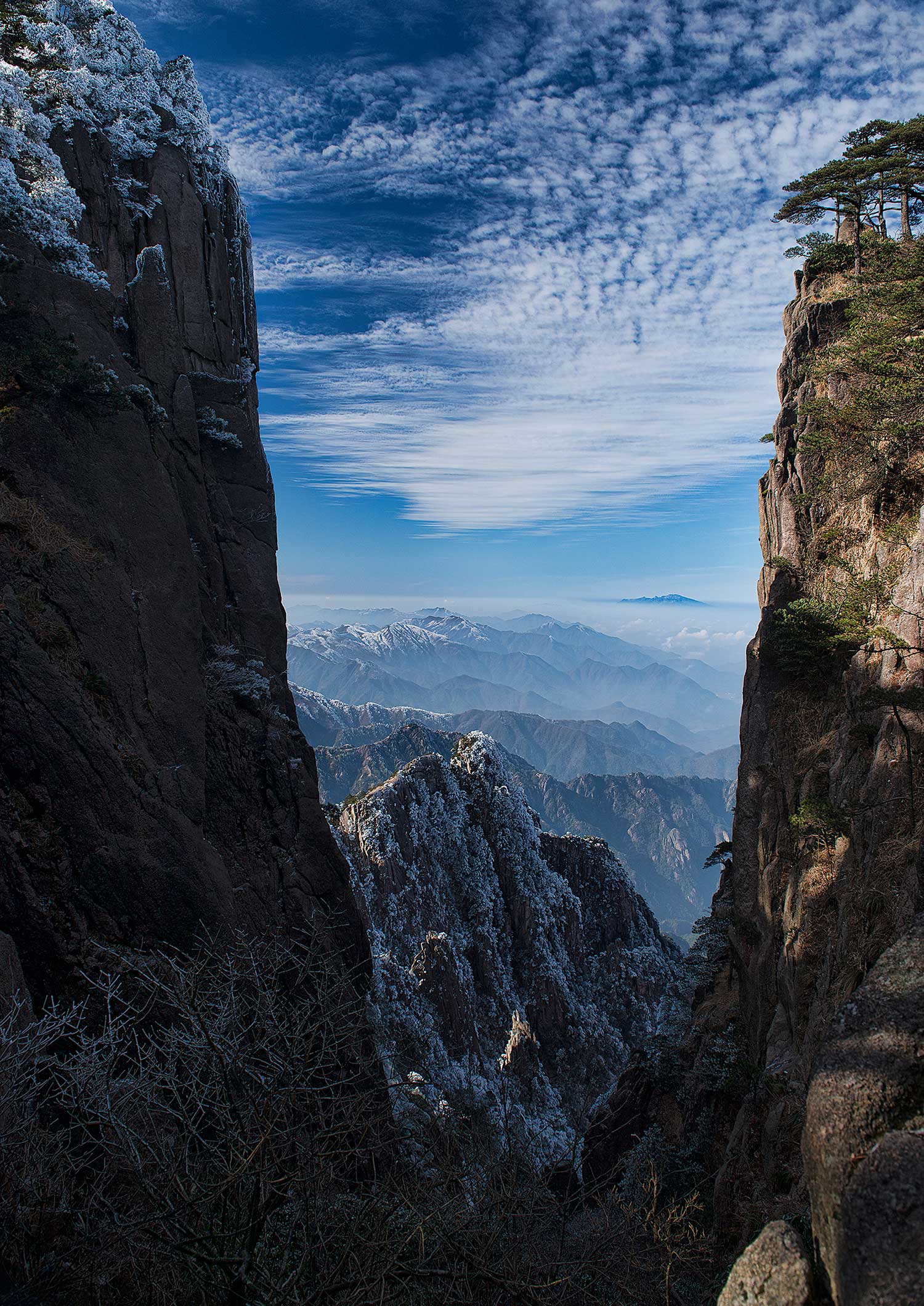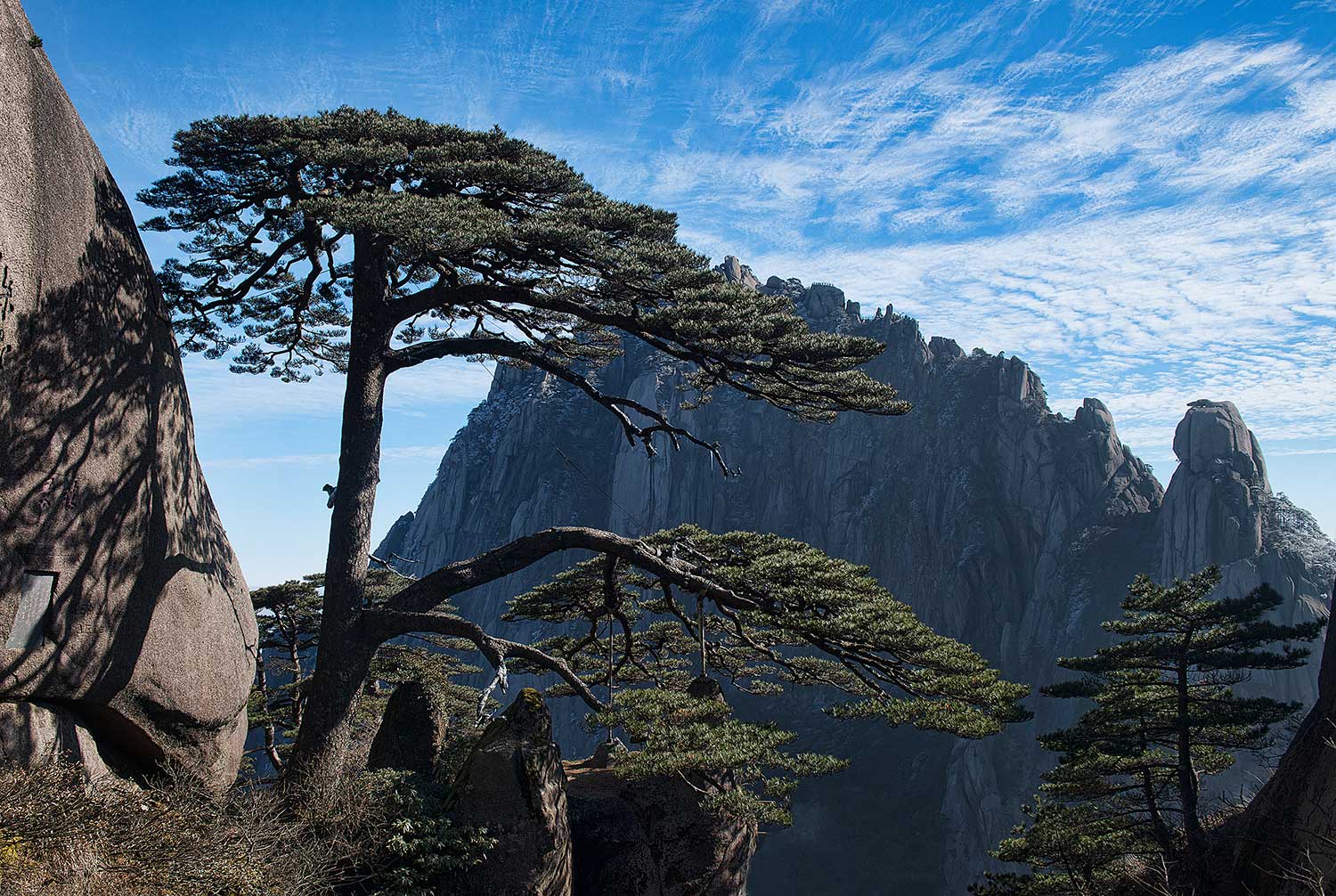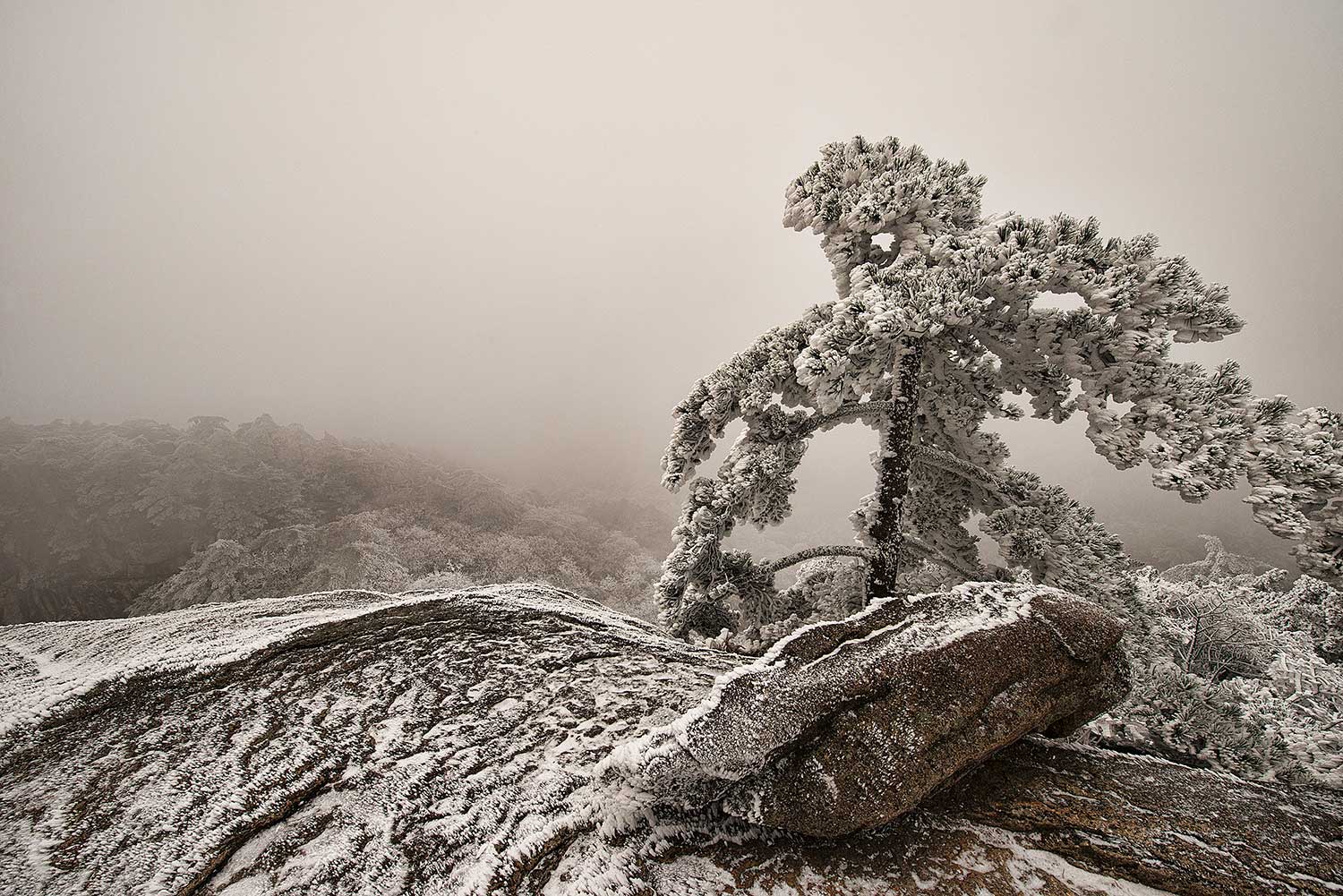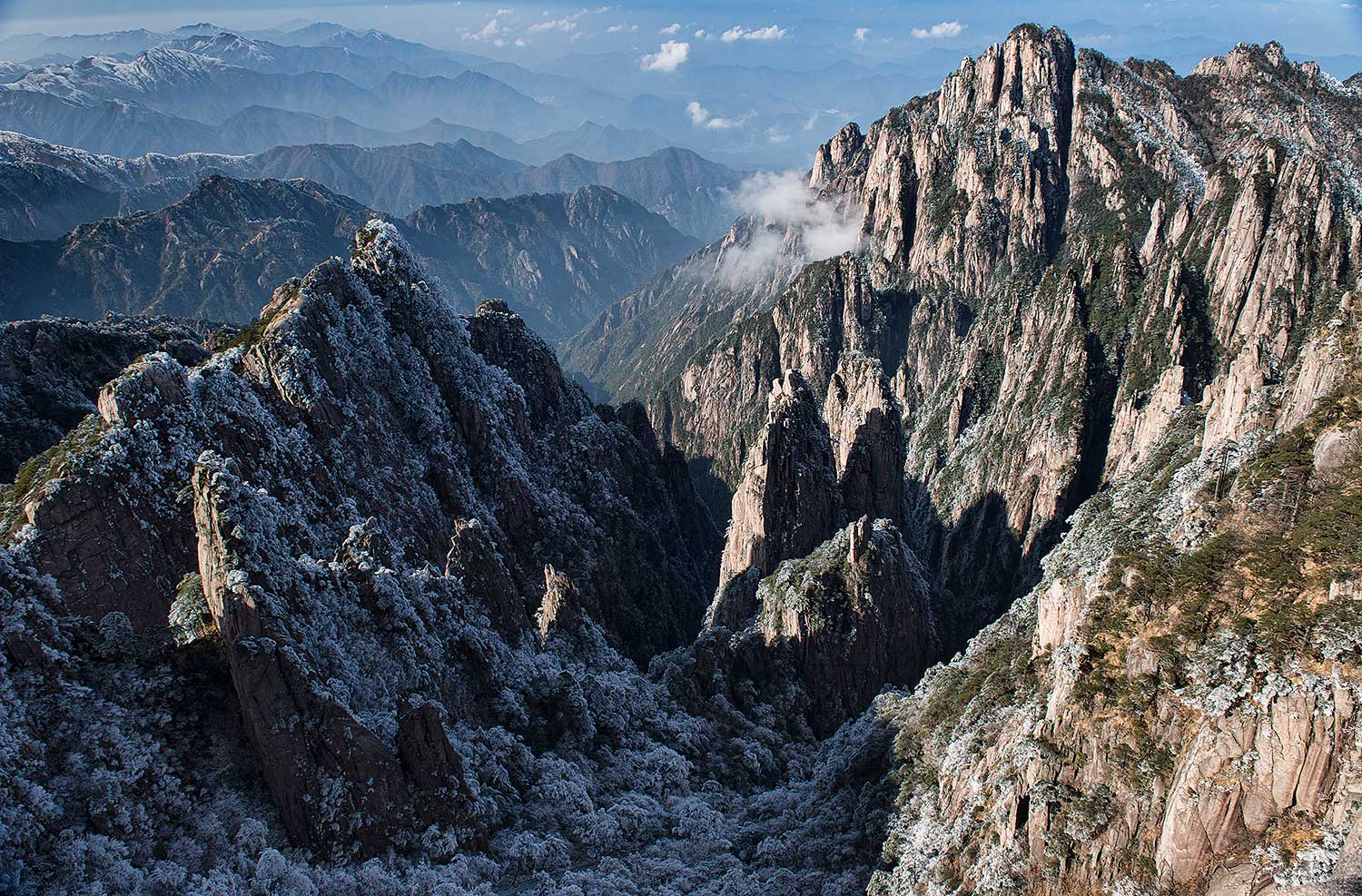
Trudging upwards into a frigid, grey, drizzle, I was trying to recollect why my wife and I had chosen to spend our Christmas break climbing a mountain in China.
With visibility registering zero and our soggy packs feeling heavier by the minute, I was having complete amnesia as to why we were here instead of some hot stretch of sand in the tropics.
I had a vague recollection that it had something to do with beautiful, jagged pinnacles draped in ice and snow, and gnarled solitary trees perched on precipices, with clouds swirling around them like the scenes one sees in old Chinese hand scroll paintings.

But for the moment, all I could see was my condensed breath, funnelling out of me like a rock concert’s fog machine.
While the ghost-gray mist might have been putting a damper on things, there’s a reason why China’s Huangshan National Park was designated a UNESCO World Heritage Site in 1990.
The park is home to hundreds of mesmerizing, jagged granite spires, often sticking right out of the passing clouds, and rising more than 3,000 feet from the valley floor.
Huangshan, meaning ‘yellow mountains’ in Chinese, gets its name not from any specific color feature, but from Huang Di, the mythological Yellow Emperor, said to have inhabited the pinnacles here as a supernatural being.
Located in Anhui Province in eastern China, the park gets thronged with tourists in the summer. They come to explore the waterfalls, caves, and hot springs surrounding the peaks, hoping for glimpses of the cloud-shrouded spires that resemble something out of an ancient landscape painting.


However, Huangshan gets over 300 millimeters of rain during the summer monsoon, the skies can be swollen for days on end, and the crowds can be insane. Winter is the driest time of year, the most likely time to get clear weather, and if you’re willing to wear a few extra layers and brave the cold, the chance to have the scenic vistas all to yourself.
If you are truly lucky, you’ll even get to see the rugged pinnacles bathed in frosty rime ice, which forms when winter precipitation condenses on the trees and cliffs.
Hollywood director James Cameron said the dramatic landscape of Huangshan was the source of inspiration for the floating mountains in his fantasy film Avatar, although Chinese netizens claimed he was confusing it with the similar peaks of Hunan’s Zhangjiajie National Forest Park.
The local government of Zhangjiajie went out and renamed one of their peaks Hallelujah Avatar Mountain, which almost started a provincial war between Anhui and Hunan. In either case, Cameron sure didn’t visit on a numbingly cold January morning like this one.

We were making progress as we trudged uphill though, as I recognized the picturesque pine tree we’d just passed that was on all the Huangshan postcards and tourist brochures we’d seen. Named ‘Welcoming Guest Pine,’ the crooked tree is over 1500 years old.
This heavenly abode has been made accessible to mere mortals these days, with comfortable hotels perched up on the ridge tops, aerial cable cars whisking visitors up into the clouds, and even stone walkways and staircases navigating various peaks. But you can still walk up from the bottom, appreciating the granite spires from their base, traipsing through mysterious dark forests, and eventually climbing up into the sky above the landscape.
We eventually reached the summit plateau, where our lodging provided respite from the wet and cold. It was a gloomy spot though in the damp conditions, and we spent most of our time there huddled around the small heater in our room, slurping instant ramen noodles.
It seemed like our timing for this adventure just wasn’t going to be fortuitous. However, a midnight peek out the window revealed that the rain had turned to heavy snowflakes falling fast, and I noted that the temperature had plummeted to -9, which signified two things, a potential for clearing skies, and the possibility of rime ice.




Rime is formed when temperatures drop between -2C and -10C after there has been moisture. Water droplets in the fog crystalize and freeze, and the forming ice attaches itself to leaves, trees, and rocks. The frozen fog moves with the frigid wind, resulting in spiky white needles and ice-laden trees that are sheathed in white on one side, yet barren on the other.
We awoke at dawn to find our lodge mates assembling their camera gear and getting themselves swaddled in down parkas and thick socks. I again looked out the window and saw that the snow had stopped, the stars were out, and the sky was completely clear. We wrapped ourselves like mummies and joined the others, walking out to a nearby overlook where macaques scurried along the railings, trying to stay warm.
The temperature was now -15, but we couldn’t complain. Swathed in our down, we had extra camera batteries stowed in our pockets and a thermos of hot coffee stuffed in our pack, and as the first orange glow of the rising sun appeared, we began to be treated to one of the most mesmerizing landscapes I had ever seen. The entire forest was covered in rime ice caused by the crystallized dense fog, with the trees and granite mountain pinnacles also iced up, towering above us and looking like standing frozen ghosts.


We threw on micro spikes to navigate the slippery paths along the cliffs, marvelled at the surrounding winter wonderland, with both trees and spires coated in a glittering white crust, and congratulated ourselves on our incredible luck and timing.
By the afternoon, a bright sun and deep blue sky transformed the landscape. The ice melted quickly, and we began our descent of the mountain by one of its most scenic trails, the Western Sea of the Grand Canyon, with views as eloquent as its name. We passed the aptly named Dispelling Cloud Pavilion and started to see all the magnificent granite the park was famed for, miles of towering formations, still with rime-covered forests at their base.
Ancient Chinese poets raved about Huangshan, and an 8th-century passage from renowned poet Li Bai commenced with the stanza, “Morning sun strikes the tree tops, here in this sky mountain world. Chinese people, raise your faces!”
Smiling through my no longer chattering teeth and gawking at the surrounding beauty some 13 centuries later, I felt just as inspired.
